
At 7am on Monday, September 14, 1964, the streets in Launceston’s CBD were switched to a new, one-way system.
In the years that followed, Launceston’s one-way street system would be refined and adapted to make way for new developments, like the Brisbane St Mall in 1975.
The one-way system went on to influence the future growth of the CBD, including the location of car parks and public transport infrastructure.
Launceston Mayor Albert van Zetten said the city’s traffic engineers had hoped the new system would improve the capacity of the CBD’s road network, make it easier to get around, and have benefits for public transport after the demise of the city’s electric trolley buses.
“They were really interested in how they could maximise the capacity and efficiency of roads in our CBD,” Mayor van Zetten said.
“However, there was one outcome of the new system they hadn’t foreseen. It’s one that is now part of the cultural fabric of Launceston — ‘blockies’.
“Blockies is a tradition that is seemingly unique to Launceston.
It involves driving circuits of the CBD at night, it celebrates car culture, and it’s also about socialising with others.”
Deputy Mayor Danny Gibson said blockies was a pastime that had earned its place in Launceston’s cultural lexicon, featuring in a recent web comedy series from Dylan Hesp and Michael O’Neill and even advertisements for National Pies.
“It’s certainly become a part of that much broader identity of who we are as a city,” Deputy Mayor Gibson said.
“Over the years the blockie route has caused the occasional problems with hooning behaviour, but it has also been a positive social outlet for many people growing up in the city. “I know married couples who met on the blockie route back in the day. There are children alive today in Launceston because of the blockie route.”
The City of Launceston’s Senior Asset Management Advisor Randall Langdon was working for the organisation in the 1970s when refinements were made to the one way system to cater for the Brisbane St Mall.
“The blockie route as we know it sprang from the introduction of Launceston’s one way street system, but it was the construction of the Brisbane St Mall which I think really cemented it into being,” Mr Langdon said.
“Other Tasmanian cities like Hobart, Devonport and Burnie didn’t ever seem to get the circuitous route we had here in our CBD. What we inadvertently created through the one-way system was a route that was ideal for cruising around the CBD and then pulling off into various car parks to socialise with others.
“That kind of social car culture has a relatively long history in Launceston and even before the blockie route, young people would congregate with their vehicles in Brisbane Street on Friday and Saturday nights.”
After a delay due to the COVID-19 pandemic, the City of Launceston will this week begin community consultation on its draft Cultural Strategy for Launceston. The City of Launceston’s Creative Arts and Cultural Services General Manager Tracy Puklowski said the strategy was aimed at maximising the city’s cultural opportunities by examining its layered stories. “When we think of what makes up Launceston’s cultural fabric, it’s many things — there are many different layers,” Ms Puklowski said.
“We have magnificent built assets like the Queen Victoria Museum and Art Gallery and the Princess Theatre; places where you can have amazing cultural experiences and see incredible art and theatre from across the globe.
“But we also have natural assets like the Cataract Gorge, as well as the rich history and cultural practices of our First Tasmanians, new arrivals from distant countries, and skilled arts practitioners. “Launceston is a city with an appreciation of the power of floods and deluge, one that sent its sons to world wars, one that recalls summer days spent at the Gorge. “And also weaved into that cultural fabric of Launceston we have things like the blockie route.
“Launceston’s culture is built on collective understandings and memories like this. They speak to us of what is unique and special about where we are and who we are as a community.” The draft Cultural Strategy lays out five proposed strategic aims for the Council:
• To respect Aboriginal Culture
• To realise the potential of our cultural places and assets
• To foster creative practices
• Reveal our cultural stories, and
• Build and extend partnerships Mayor van Zetten encouraged residents visit www.yourvoiceyourlaunceston.com.au and to complete a short survey before consultation closes on August 28.
“We want to have a good understanding of what Launceston’s cultural strengths are, which is why feedback from the community is important to us,” Mayor van Zetten said.
“That will allow us to begin work on the second phase of this project, which will be aimed at developing actions arising from the feedback we’ve received.”





